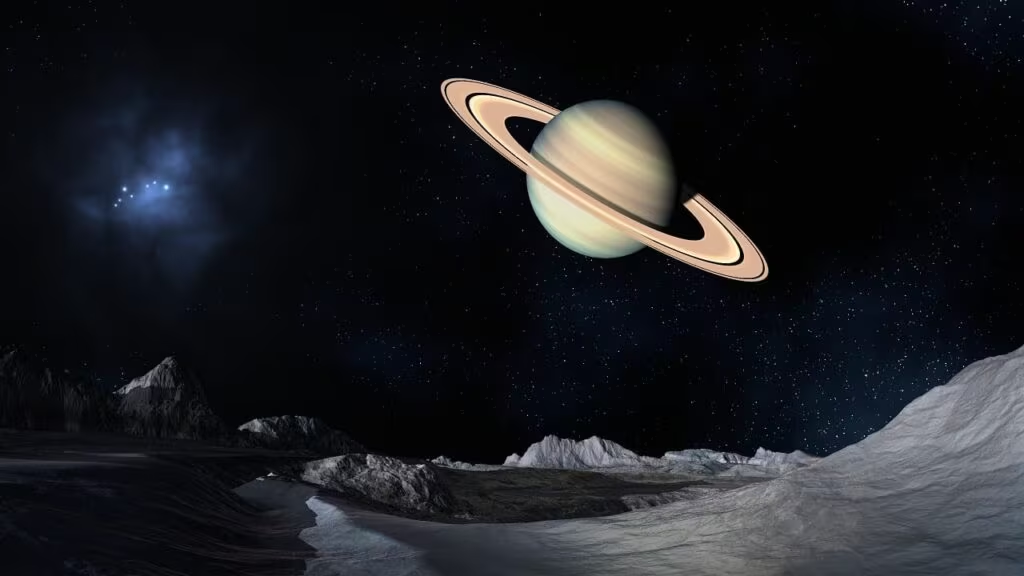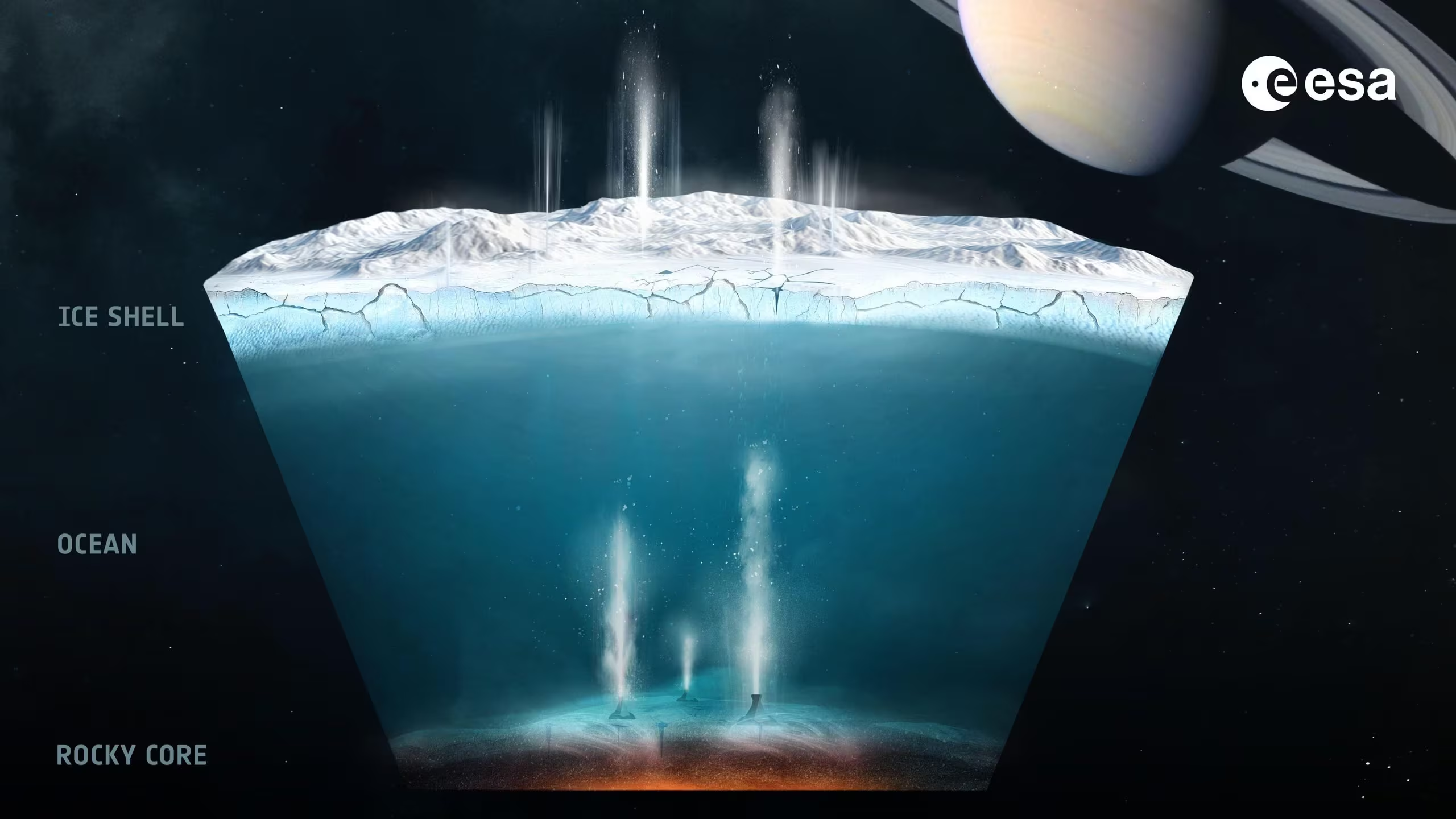NASA Confirms Unexpected Energy Driving Saturn’s Icy Moon
One of the most profound discoveries in planetary science—the confirmation of a vast, subsurface ocean on Saturn’s moon Enceladus—has been dramatically enhanced by new analysis of data from the NASA/ESA Cassini-Huygens mission. Scientists have confirmed that the moon is leaking a massive amount of heat from its south polar region, far exceeding what standard geological models predict.
This hidden thermal energy, concentrated around the famous geysers that erupt into space, provides compelling evidence that Enceladus possesses not just liquid water, but a powerful, sustained energy source. This finding significantly elevates Enceladus’s status as one of the most promising locations in the solar system to search for extraterrestrial life.
The data, collected by Cassini before its mission concluded in 2017, suggests that the energy output is so high it requires a dynamic, internal mechanism—likely hydrothermal activity driven by gravitational forces—to sustain the moon’s liquid environment for billions of years.
Unpacking the Cassini Measurements
The Cassini spacecraft, which orbited Saturn from 2004 to 2017, provided unprecedented views of Enceladus, including the discovery of plumes of water vapor and ice particles jetting from fissures near the south pole, nicknamed “tiger stripes.” The new analysis focused on precisely measuring the thermal radiation escaping from these regions.
The Thermal Anomaly
Researchers found that the total heat output from the south polar region is estimated to be around 11 to 15 gigawatts. To put this into perspective, this is roughly the energy output of several large power plants combined, all concentrated in a relatively small area. This figure is far higher than the heat that could be generated solely by the decay of radioactive elements in the moon’s core, which is the primary heat source for many smaller, geologically inactive bodies.

This massive thermal output implies that a much more powerful, non-radioactive mechanism is at work, actively heating the moon’s interior. This mechanism is crucial because it addresses the long-standing question of how a small, icy moon, only about 500 kilometers in diameter, can maintain a global, liquid ocean beneath its icy shell.
The Engine Driving Habitability: Tidal Flexing
Experts believe the mechanism responsible for this extreme heat is tidal dissipation, generated by the immense gravitational pull of Saturn. Enceladus orbits Saturn in an elliptical path, causing the moon to be constantly stretched and squeezed by the planet’s gravity.
How Tidal Forces Create Heat:
- Orbital Dynamics: As Enceladus moves closer to and farther from Saturn, the gravitational stress changes dramatically.
- Core Friction: This constant flexing creates friction within the moon’s rocky core, converting mechanical energy into thermal energy.
- Hydrothermal Circulation: This heat is then transferred to the water at the boundary between the core and the subsurface ocean, driving hydrothermal vents—a process similar to those found deep in Earth’s oceans.
“The sheer magnitude of the heat flow suggests that the friction is occurring deep inside the moon, likely in the porous, rocky core, where water is interacting directly with the heated rock,” explained one researcher involved in the analysis. “This is a game-changer for understanding the longevity and chemistry of the ocean.”

The Astrobiological Significance
The discovery of sustained, powerful heat is arguably as important as the discovery of the ocean itself when considering the potential for life. For an environment to be habitable, it requires three fundamental ingredients:
- Liquid Water: Confirmed by the plumes and ocean.
- Essential Chemistry: The interaction between hot rock and water provides the necessary minerals and chemical gradients (like methane and hydrogen) that can serve as food for microorganisms.
- Energy Source: The newly confirmed tidal heating provides the robust, long-term energy needed to power biological processes, even in the absence of sunlight.
On Earth, hydrothermal vents support chemosynthetic ecosystems that thrive without photosynthesis. The chemical environment created by the hot, mineral-rich water interacting with the cold ocean on Enceladus could potentially foster similar life forms.
Comparison to Europa
While Jupiter’s moon Europa is also known to harbor a subsurface ocean heated by tidal forces, the heat signature on Enceladus is directly observable via the plumes, providing a unique opportunity for future missions. The plumes act as natural sampling mechanisms, bringing material from the ocean floor directly into space where it can be analyzed without having to drill through the thick ice crust.
Implications for Future Missions
The Cassini mission, which ended with the spacecraft plunging into Saturn’s atmosphere, provided the foundational data for this analysis. This finding directly informs the design and objectives of future missions targeting ocean worlds.
For example, missions currently under consideration, such as those focused on detailed plume analysis, will be designed to measure specific chemical signatures that indicate active hydrothermal vent systems. These missions would search for complex organic molecules and biosignatures—chemical evidence of past or present life—that are likely being generated and carried upward by the confirmed strong thermal flow.
This confirmation of a powerful, long-lived energy source ensures that Enceladus will remain a top priority for astrobiological exploration in the coming decades.

Key Takeaways
The analysis of Cassini data provides definitive evidence of extreme internal heating on Enceladus, fundamentally changing our understanding of its potential for habitability:
- Massive Heat Output: The south polar region emits 11 to 15 gigawatts of thermal energy, far exceeding radioactive decay models.
- Source Mechanism: The heat is primarily generated by tidal flexing—Saturn’s gravity stretching and squeezing the moon’s rocky core.
- Hydrothermal Activity: This friction likely drives hydrothermal vents on the ocean floor, creating chemical energy gradients.
- Habitability Boost: The sustained heat provides the necessary long-term energy source required for chemosynthetic life, alongside liquid water and essential chemistry.
- Future Focus: The findings reinforce Enceladus as a prime target for follow-up missions seeking direct evidence of biosignatures in the plumes.
Conclusion: A World Primed for Life
The hidden heat on Enceladus is not merely a geological curiosity; it is the engine that transforms a frozen ball of ice into a dynamic, chemically active world. By confirming a robust and long-lasting energy source, scientists have filled a critical gap in the habitability equation for this distant moon. While the Cassini mission did not find life, its legacy continues to provide the strongest evidence yet that the conditions necessary for life—liquid water, complex chemistry, and sustained energy—are all present and active beneath the icy crust of Enceladus, making the prospect of finding extraterrestrial biology more tangible than ever before.
Originally published: November 7, 2025
Editorial note: Our team reviewed and enhanced this coverage with AI-assisted tools and human editing to add helpful context while preserving verified facts and quotations from the original source.
We encourage you to consult the publisher above for the complete report and to reach out if you spot inaccuracies or compliance concerns.

